Civil
War Campaign Drive
a
road-trip through Virginia,
Maryland and Gettysburg in July 2003
by
Bill McIntyre

Introduction
For
over fifteen years I had promised myself a tour of the US Civil War
battlefields. In July 2003 I finally kept my promise. Together with
former Royal Hong Kong Police colleague Gavin Ure, I undertook a nine-day
tour of civil war battlefields mainly in Virginia and points of interest en
route. Herewith an account of
the campaign drive.
Although
there was no plan for this grand tour, I believe that a sequence of
battlefield visits emerged that in parts mirrored the actual course of the
war in the eastern states and overall gave an insight into the logistical
and strategic issues that determined the outcome of the war.
As
general observations, I came away with no clear reasoning as to the causes
of the war. I did come to admire and respect those who played key
roles in the conflict such as, on the Confederate side, President Jefferson
Davis, General Robert E. Lee and Lt. General
Thomas J. “Stonewall” Jackson, and, on the Union side, President
Abraham Lincoln, General Ulysses S. Grant, General George G. Meade,
Brigadier Joshua L. Chamberlain, to name but a few.
Many of the major battlefields lie within a short distance of either
Richmond the Confederate capital, or Washington the Federal capital – this
theatre of the war was conducted within a surprisingly small area. The US
National Parks Service performs an excellent job of providing facilities for
visitors at each site including guided tours of the main points of interest.
As far as possible the sites and buildings that remain have been
preserved and the preservation work continues.
Richmond:
Embattled Capital 1861-65
Friday
July 11th 2003. Richmond, Capital of The Confederacy.
The
starting point of the grand tour, and to my mind amongst the most memorable.
The Museum of the Confederacy and the adjacent White House of The
Confederacy in Richmond are both highly recommend. The museum houses
the nation’s largest collection of civil war artefacts. The
historical tours of The White House, where Jefferson Davis resided with his
family, give an invaluable insight into how the Confederacy was run.
Davis was formerly the US Secretary for War. No photographs are
permitted in The White House – one scene that I would like to have
captured on film was the main living room complete with the very table at
which President Davis sat with General Robert E. Lee and other Confederate
military staff to plan and deliberate the war.
Another
happy memory I have of Richmond is the stunning Southern beauties that you
will see in this city. Refined,
of good breeding and porcelain in complexion, I know of no finer city at
which a gentleman may seek a wife.
Dinner
in Richmond was at The Tobacco Company – an excellent place both for
dining as also for solving the world’s problems at a fine saloon
bar. This is situated in the cobbled Shokoe Slip area of bistros and
taverns that is centred on East Cary Street.
Battle
of Fredericksburg: December 11th to 13th 1862
Saturday
July 12th 2003. Fredericksburg, Virginia. (Exit 130, Interstate
95)
A
Friday evening drive to the Hampton Inn in Fredericksburg ensured a morning
start for the first battlefield. The US has excellent hotel chains such as
Hampton Inns that provide a good standard of accommodation at reasonable
cost.
|
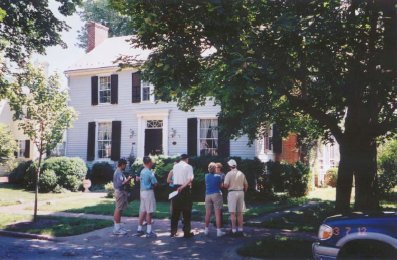
|
|
National Parks Service
Ranger tour of downtown area of Fredericksburg - the river is behind
the house. |
Lying
within a fifty-mile radius of Washington, D.C., this historic town is now a
gentrified commuter town for Washington.
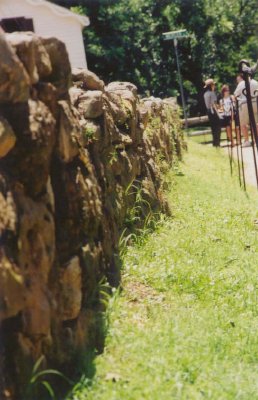 |
|
The 'Stonewall' and
sunken lane |
Those
who enjoyed “Gods and Generals”, the film depicting the life of General
Stonewall Jackson, will appreciate Fredericksburg. At the Visitor Centre is
the very stone wall behind which the Confederate defenders lined up in the
Sunken Road to pour constant musket fire into the oncoming attack lines of
Union troops.
In
addition to a guided walking tour of the wall area, the National Parks
Service Rangers also conduct walking tours of the historic residential area
down by the Rappahannock River. The start location for the residential
area tours is a short drive from the Visitor Centre.
Both tours are recommended, as is the Visitor Centre presentation.
Allow half a day to see both tours and longer should you wish to
explore the other sites in this town such as Chatham Plantation House where
the graffiti inscribed by union troops can still be seen, or the Stonewall
Jackson Shrine located a few miles to the South where on May 10th
1863, Jackson died of wounds that had been inflicted by Confederate troops
at Chancellorsville who had mistaken Jackson and his lieutenants for Union
cavalry.
Lunch
at a nearby chain restaurant “Bob Evans” was adequate but not
commendable. Lamentably, there are few worthy places to eat in the
vicinity of the Visitor Centre.
First
Manassas - First Battle of Bull Run: July 18th to 22nd
1861.
(Second
Manassas – Second Battle of Bull Run: August 28th to 30th
1862.)
Saturday
Evening and Sunday morning: July 12th and 13th 2003:
Manassas, Virginia (Exit 47 on Interstate 66, take State Road 234 North from
the town of Manassas).
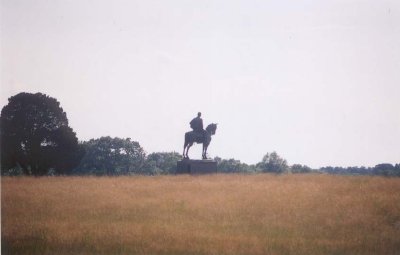 |
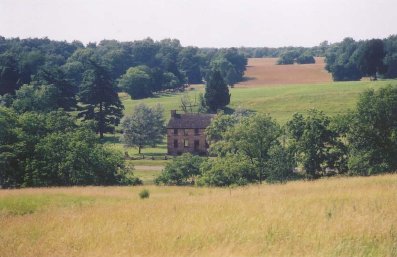 |
| The Stonewall
Jackson Statue, First Battle of Manassas |
View of the
stone house from the Confederate position, which served as a field
hospital in both First and Second Manassas |
The
battlefield of First Manassas lies amongst pleasant rolling rural
countryside. The large statue of Stonewall Jackson mounted on his charger,
is emblazoned with the immortal line uttered by Brigadier Bernard Bee: "There
stands Jackson like a stonewall".

|
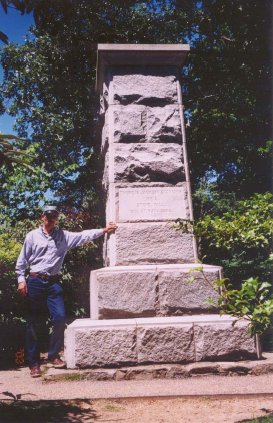 |
|
Monument
to Stonewall Jackson at
First
Manassas (Bull Run) battlefield |
Memorial to
Stonewall Jackson at the location where he was tragically shot by
Confederate troops who mistook him and his accompanying staff for the
enemy |
Bee
was in fact wearing his Union blue frock coat when he led his troops into
battle at the First Manassas, or First Battle of Bull Run as the
Confederates named the battle. He was killed in action later in the
battle.
The
First Manassas battlefield can be walked easily as the field of action was
limited. The duration of combat was short-lived primarily because the
Union forces’ withdrawal rapidly degenerated into a rout.
The
Second Manassas battle area is more of a driving tour and would have
required a further day to capture the main points of interest.
The
National Parks Service has preserved the field of battle; points of interest
are well marked without detracting from the views from each vantage point.
Monacacy:
July 9th 1864
Sunday
July 13th 2003: Monacacy Battlefield, 4801, Urbana Pike, off the
Georgetown Pike (also known as Route 355 - travel south from Interstate 70),
Maryland. (Visitor Centre: Tel: 301-662 3515).
Situated
just South of the town of Frederick, Monocacy is a lesser known battle but
nonetheless an important de facto Union victory. Although the 2,500
Union forces commanded by Major General Lew Wallace were both outnumbered
and raw, they fought a determined delaying action that enabled General Grant
to reinforce the capital Washington so that it could be defended from
imminent attack. The superior Confederate forces of some 25,000
commanded by General Jubal Early had been ordered by General Lee to march on
the unprotected Federal capital of Washington and the Maryland city of
Baltimore. Lee had seen the opportunity to attack as both cities had
been left under-defended whilst the Union forces concentrated their efforts
on the sieges of Richmond and Petersburg.
During
July local farmers allow visitors to enter their land and the Parks Service
Visitor Centre conducts walking tours of these usually out of bounds areas.
The Centre provides driving tour leaflets.
“The
Monacacy Crossing” (Tel: 301-831 4878) is recommended for lunch.
Very much a biker gourmet bar with ‘a fresco’ dining, one can watch the
hogs accelerate up the hill whilst enjoying a Pinot Grigio or Chardonnay.
The wine list is excellent. Turn left out of the Visitor Centre and it
is a mile or so on the right.
Antietam
(Sharpsburg): September 17th 1862
“THE
BLOODIEST DAY IN THE CIVIL WAR”
Sunday
Afternoon July 13th and Monday July 14th 2003:
Antietam National Battlefield, North of Sharpsburg on Maryland Route 65.
(Visitor Centre Tel: 301-432 5124).
More
men were wounded or killed on this day than on any other day in the civil
war.
The
Confederate Force under Lee was initially outnumbered two to one and faced a
Union army prepared because they had by chance captured Lee’s orders prior
to the battle. The arrival of Stonewall Jackson’s forces, and later
those of General A. P. Hill (both marching from their actions at Harper’s
Ferry) helped balance the battle. Lee ultimately failed in this attempt to
obtain a much sought after victory on Union soil. Meanwhile, the lack of
decisive action by Union General George McClellan allowed a golden
opportunity to annihilate Lee’s army before it was reinforced slip by.
A
complex battle. The scale of the battlefield and lie of the land make
it confusing for those less well versed in the stages of the conflict.
One of the most impressive battlefield tour talks that I heard during the
campaign was given by a junior National Parks Service Ranger at
Antietam. The narrator was a university history student from
Michigan. I observed a number of history students working as National
Parks Service Rangers who follow their passion during their vacations by
working at National Parks battlefields.
The presentation was one of the most succinct explanations of the
reasons for a battle, the directions of each major unit, and the stages and
progress of the battle that I have ever heard. Without reference to
notes and speaking to an audience seated not in an auditorium but on a
grassy bank overlooking the battlefield, he was able to give an informative
and lucid account of what happened. Above all he enabled the audience
to orient themselves before embarking on individual walking and driving
tours.
 |
| Park Ranger
lecture on Antietam |
Memorable
sites are The Bloody Lane and the so-called Burnside Bridge. The Union
General Ambrose E. Burnside fought to take the bridge but was held off by a
small unit of Georgia rifleman. By
the time he had taken the bridge and advanced to cut off Lee’s line of
retreat, A.P. Hill’s forces had arrived on the field and stopped
Burnside’s advance.
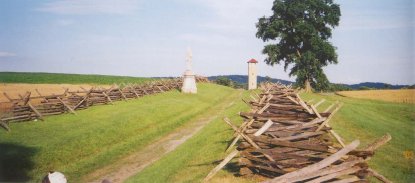 |
|
The
"Bloody Lane" where for 4 hours Confederate and Union troops
contested
this sunken road resulting in over 5,000 casualties |
|
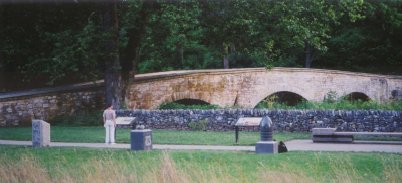
|
| Burnside
Bridge, Antietam |
The
immediate area of Antietam is not well served for accommodation or
restaurants and local hotels book up quickly during the holiday season.
There are a few modest hotels in nearby Hagerstown; there is a Texas
Roadhouse (Tel: 301-739 2200) in Hagerstown that serves a good size steak in
a raunchy but friendly atmosphere.
The
Battle of Gettysburg: July 1st to 3rd 1863
Monday
July 14th and Tuesday July 15th 2003: Gettysburg
National Military Park, Gettysburg, Pennsylvania. (Visitor Center Tel:
717-334 1124).
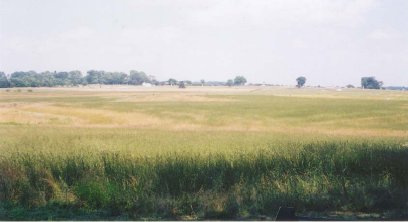 |
|
Cemetery
Ridge, Gettysburg, from the Confederate position -
Pickett's
Charge started from this location in the Confederate centre |
Seemingly
the largest battlefield, Gettysburg is the most crowded, most monumented,
most emotional, most argued and written about, and the most famous civil war
battlefield in the USA. Pickett’s Charge, The High Tide of the
Confederacy, Devils Den, Little RoundTop, The Peach Orchard, Culp’s Hill.
And many more. The driving tour is excellently markered.
Gettysburg is a day’s touring, at least. However, even though each
visitor wants to explore at his or her own pace I would recommend taking one
of the two-hour guided tours. The
tour guide will drive your car allowing you to relax and better appreciate
each place on the battlefield that you visit. Tours can be booked at the
Visitor’s Centre but slots will be quickly booked during holiday periods
and at weekends necessitating an advance booking.
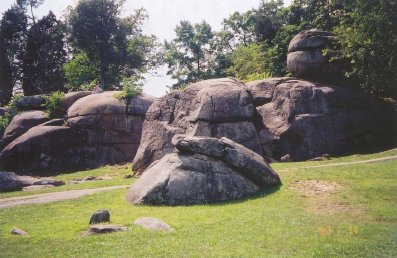 |
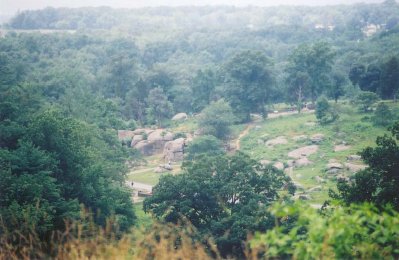 |
| Devil's
Den |
Devil's
Den seen from the Union position on Little Round Top |
One
highlight of the visit was a lone Union fifer on Cemetery Ridge,
immaculately turned out in the Blues of an Irish regiment, playing marching
tunes from the era. The fife playing echoed across the valley.
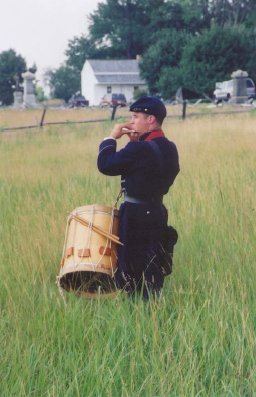 |
| Lone
Fifer, Cemetery Ridge, Gettysburg |
The
battlefield adjoins the town of Gettysburg and the town is full of
bookshops, civil war relic shops and other gift shops related to the
era. The town itself is historic containing many buildings that
witnessed the battle – the pock marks of musket and shrapnel can often be
seen. And above all it is a
walking town.
Gettysburg
has a wide range of accommodations. For
those who enjoy staying in a rambling mansion complete with oak staircase, a
recommended bed ‘n breakfast is the Keystone Inn, 231 Hanover Street,
Gettysburg, PA 17325 (Tel: 717-337 3888).
Gettysburg
is well served with taverns and restaurants and also has some good
bookshops. Commercialised –
yes. Crowded in the holiday seasons – yes.
But essential for students of The War Between the States.
Old
Town Alexandria, Virginia
Washington
D.C.
Tuesday
Evening July 15th and Wednesday July 16th 2003.
To
recuperate from the serious touring a side trip was taken to Alexandria,
Virginia and to Washington, D.C.
Recommended
lodging at a reasonable rate is the Best Western Old Colony Inn, 1101 North
Washington Street, Alexandria, Virginia 22314 (Tel: 703-739 222; Fax:
703-549 2568). Old Town Alexandria is a walking town but the hotel does
provide a shuttle bus to both the Alexandria downtown area and to the
nearest Metro Station enabling one to take a train and visit Washington,
D.C.
 |
| The
Lincoln Memorial |
A
highly recommended American Revolutionary War period alehouse and tavern
with a genuine 18th
Century atmosphere, is Gadsby’s Tavern, 138 N. Royal Street, Old Town
Alexandria (Tel: 703-548 1288). George Washington dined there. The menu
seeks to recreate the famous dishes of the day and staff wear period
costumes. Reservations recommended. The tavern has been
preserved and there are tours during the day of the floors above the dining
area that for many years served as one of Alexandria’s inns.
Another
famous mansion worth touring in Old Town is The Lee-Fendall House – the
family of General Robert E. Lee resided here and they had strong connections
with the family and descendants of George Washington. 614 Oronoco Street,
Old Town Alexandria (Tel: 703-548 1789).
The
visit to Washington D.C. was somewhat of a digression from the civil war.
There are many historical sites – too many for this report to do
them justice. Arlington Memorial Cemetery, the Lincoln Memorial, the Vietnam
War Memorial and the Korean War Memorial are recommended sites to visit.
Interestingly, Arlington Cemetery is the former Lee Family plantation
that was sequestered by the Federal government during the civil war to
provide a military cemetery. The
ante bellum mansion remains open as part of the tour of Arlington Military
Cemetery. A lesser known but magnificent monument at Arlington Cemetery is
the Confederate memorial erected by the United Daughters of the Confederacy.
The
Battle of Chancellorsville, April 27th to May 6th 1863
The
Battle of the Wilderness, May 5th to 6th 1864
The
Battle of Spotsylvania Court House, May 8th to 21st
1864
Thursday
July 17th 2003: Fredericksburg and Spotsylvania National Military
Park, situated West of Fredericksburg, accessed from Interstate 95 exit 130.
The
civil war park includes not only the Battle of Fredericksburg (toured
earlier) but also the Chancellorsville Campaign that included the battles of
Chancellorsville, Second Fredericksburg, the Battle of the Wilderness and
the Battle of Spotsylvania Courthouse. A
fee paid at either the Fredericksburg or Chancellorsville Visitor Centres
covers access to all of the military parks.
Each
battle is a study in itself. The
driving tour is fairly well marked. Spotsylvania and The Wilderness do not
have full Visitor Centres; only at Chancellorsville is there a full Visitor Centre.
At
Chancellorsville, Stonewall Jackson marched 12 miles to attack the weak
right flank of the Union forces commanded by the newly appointed Union
General Joseph Hooker. Lincoln had replaced General Burnside with Hooker
following the Union disaster at Fredericksburg.
Tragedy
occurred on that fateful May 2nd day when Stonewall Jackson was
shot in error by Confederate troops who were unaware that he was reconnoitring
with his staff officers in their vicinity. The location of the
accidental shooting is marked by an obelisk.
Park Rangers are keen to avoid answering the question as to what
would have happened at Gettysburg had Stonewall not been shot.
The
“Bloody Angle” at Spotsylvania marked some of the heaviest fighting and
is now set amongst trees and pleasant rolling pastures. Very quiet and
poignant.
Petersburg,
Virginia: Under Siege June 1864 to April 1865
Thursday
afternoon July 17th and Friday morning July 18th 2003:
Petersburg – located South of Richmond on Interstate 95. The North
side of the town is on the banks of the Appomattox River.
Visitor Centre: 425 Cockade Alley, Old Town. (Tel: 804-733 2400;
1-800 368 3595).
The
longest siege endured by an American city in US history: 292 days.
Petersburg
was devastated during the siege and has been depressed ever since. A brick
city that was rebuilt in brick in the 1830s following a disastrous fire,
there are thus many buildings that have survived the civil war and show the
scars of the siege.
The
Siege Museum, 15 Bank Street (Tel: 804-733 2402) within walking distance of
the Visitor Centre is a small but thoughtful display and account of what
life was like during the siege. The
late actor Joseph Cotton was raised in Petersburg and recorded a short but
eloquent narrative of the siege “The Echoes Still Remain” – shown
regularly at the museum.
A
short drive from downtown is The Blandford Church, 319 South Crater Road
(Tel: 804-733 2396). A historic eighteenth century parish church built
in 1735, it became a Confederate memorial chapel decorated with magnificent
Tiffany stained glass windows – each window was commissioned by each of
the southern states that fought for the Confederacy. The church served
as a field hospital during the siege.
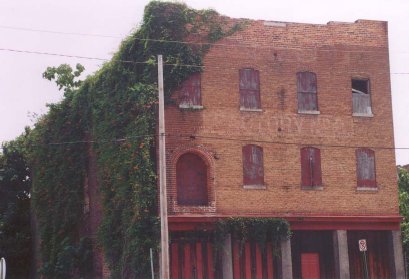 |
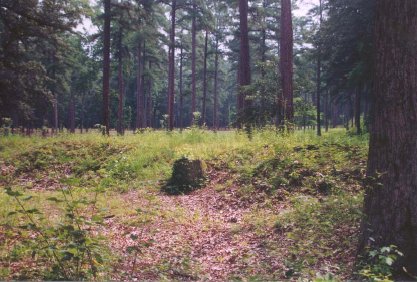 |
| Petersburg:
the longest siege in US history |
Siege
of Petersburg: The Crater |
A
sixteen mile driving tour of the siege line follows the main siege defence
points and includes The Crater where on July 30th 1864, Union
forces attempted to break the siege by tunnelling under a Confederate fort
and exploding a massive mine. Union forces then rushed into the immense
crater created by the blast but found themselves trapped inside it and
suffered heavy casualties – the siege continued.
A
recommended bed n’ breakfast in Petersburg is The High Street Victorian
Inn, 405 High Street, Petersburg, Virginia 23803.
Reservations recommended (US$90.00 to US$125.00 per night.
(Reservations Tel: 866 477 8466; Tel: 804-733 0505; Fax: 804-863 4460;
Email: highst@ctg.net).
Without
a reservation it may be difficult to find suitable accommodation in
Petersburg - there are a number
of hotel chains situated in the Colonial Heights area just north of the town
on Interstate 95 e.g. The Comfort Suites, 931 South Avenue, Colonial
Heights, VA 23834 (Tel: 804-520 8900) (Interstate 95 Exit 53).
Dining
options in Petersburg are limited but a highly recommended tavern is The
Brick House Run a British style pub with excellent choice of ales and
equally excellent tavern fare. Built in the old section of the town near to
the Visitor Centre, it recreates a tavern of yore and the owners Ella and
Steve Dickinson toured and studied historic taverns in Britain before
setting it up. 407-409 Cockade Alley, Petersburg, VA 23803 Tel: 804-862
1815). Dining Tuesdays through Saturdays.
City
Point, The James River (Hopewell), Virginia.
Thursday
afternoon July 17th 2003: Grant’s Headquarters, Siege of
Petersburg, Virginia.
City
Point on the James River was Grant’s headquarters and is a modest drive
East from Petersburg. It was the main supply point for the Union
effort to take Petersburg. The National Parks Service has preserved
the cabin in which General Grant slept and tours give an interesting account
of the logistics involved in mounting the siege.
Richmond:
The Seven Days’ Battles: Beaver Dam Creek June 26th 1862;
Gaines Mill June 27th 1862
; Cold Harbor May 31st to June 12th 1864. Richmond,
Virginia
Friday
afternoon July 18th Saturday July 19th 2003.
Battle sites surrounding Richmond, Virginia.
There
are a multitude of battlefield sites and defence lines surrounding
Richmond. With limited time those touring the area will have to select
those in which they have the greatest interest.
For
those that have the time available there is an eighty-mile driving tour of
the entire Richmond National Battlefield Park. Major sites include Cold
Harbor which has a Visitor Centre and the battlefield sites of Gaines Mill,
Beaver Dam, Glendale (Frayser’s Farm), Fort Harrison Visitor Centre,
Malvern Hill, Drewry’s Bluff (Fort Darling), Richmond National Battlefield
Park Visitor Centre at downtown Richmond (Tel: 804-226 1981).
 |
| Richmond:
the battle of Beaver Dam Creek |
The
Beaver Dam site is a sign by the road with a visitor car park and a walking
tour conducted at certain times of the day by National Parks Service
Rangers. Gaines Mill Battlefield site also has a walking trail and
scheduled walking tours with National Parks Rangers but no Visitor Centre.
Cold
Harbor provides an informative Visitor Centre and a mile and a half driving
or walking tour. Despite decades of weathering, the trenches of both
Union and Confederate troops are still clearly visible along the lines of
the battle.
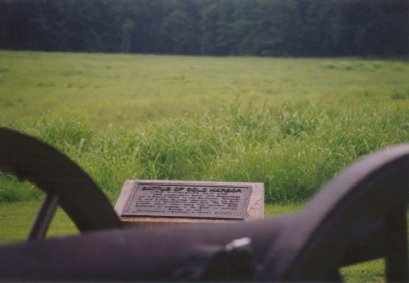 |
 |
| Views of the battlefield at Cold
Harbor |
Cold
Harbor was a major chapter in the defence of Richmond. On June 3rd
1864, an estimated 6,000 Union forces fell in one hour of disastrous
assaults made on the Confederate lines.
Grant’s march on Richmond from The Wilderness and Spotsylvania
Court House Battles was stopped at Cold Harbor. In response to the
heavy losses suffered from his attempt to take Richmond by a direct attack,
General Grant moved South to lay siege to Petersburg, a major supply point
for Richmond. The eventual taking of Petersburg sealed the fate of
Richmond. Although the Confederate capital had not suffered the same direct
bombardment that had been inflicted on Petersburg, it had become the
destination for thousands of Confederate civilian refugees who faced
starvation, disease and lack of clothing and shelter. The fall of
Petersburg cut off supplies essential
to the viability of Richmond.
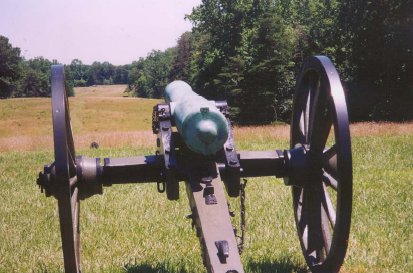 |
 |
| "The Echoes Still
Remain"
|
back
to expeditions
or
back
to american civil war
|